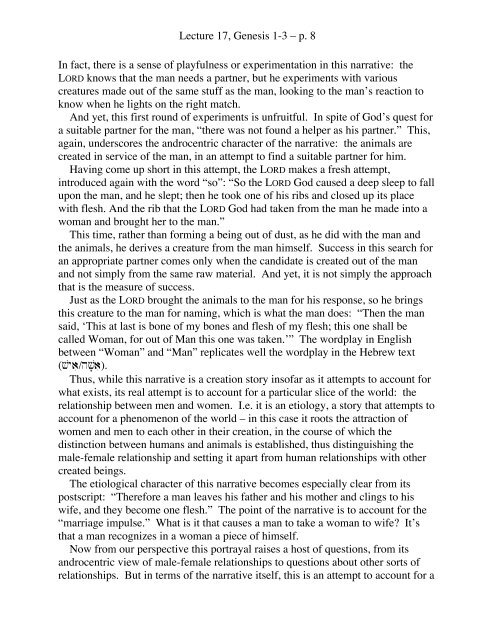Lecture 17: The Primeval Narrative (Genesis 1-3) History-telling in ...
Lecture 17: The Primeval Narrative (Genesis 1-3) History-telling in ...
Lecture 17: The Primeval Narrative (Genesis 1-3) History-telling in ...
Create successful ePaper yourself
Turn your PDF publications into a flip-book with our unique Google optimized e-Paper software.
<strong>Lecture</strong> <strong>17</strong>, <strong>Genesis</strong> 1-3 – p. 8<br />
In fact, there is a sense of playfulness or experimentation <strong>in</strong> this narrative: the<br />
LORD knows that the man needs a partner, but he experiments with various<br />
creatures made out of the same stuff as the man, look<strong>in</strong>g to the man’s reaction to<br />
know when he lights on the right match.<br />
And yet, this first round of experiments is unfruitful. In spite of God’s quest for<br />
a suitable partner for the man, “there was not found a helper as his partner.” This,<br />
aga<strong>in</strong>, underscores the androcentric character of the narrative: the animals are<br />
created <strong>in</strong> service of the man, <strong>in</strong> an attempt to f<strong>in</strong>d a suitable partner for him.<br />
Hav<strong>in</strong>g come up short <strong>in</strong> this attempt, the LORD makes a fresh attempt,<br />
<strong>in</strong>troduced aga<strong>in</strong> with the word “so”: “So the LORD God caused a deep sleep to fall<br />
upon the man, and he slept; then he took one of his ribs and closed up its place<br />
with flesh. And the rib that the LORD God had taken from the man he made <strong>in</strong>to a<br />
woman and brought her to the man.”<br />
This time, rather than form<strong>in</strong>g a be<strong>in</strong>g out of dust, as he did with the man and<br />
the animals, he derives a creature from the man himself. Success <strong>in</strong> this search for<br />
an appropriate partner comes only when the candidate is created out of the man<br />
and not simply from the same raw material. And yet, it is not simply the approach<br />
that is the measure of success.<br />
Just as the LORD brought the animals to the man for his response, so he br<strong>in</strong>gs<br />
this creature to the man for nam<strong>in</strong>g, which is what the man does: “<strong>The</strong>n the man<br />
said, ‘This at last is bone of my bones and flesh of my flesh; this one shall be<br />
called Woman, for out of Man this one was taken.’” <strong>The</strong> wordplay <strong>in</strong> English<br />
between “Woman” and “Man” replicates well the wordplay <strong>in</strong> the Hebrew text<br />
(#$y)i/h#$ @f)i).<br />
Thus, while this narrative is a creation story <strong>in</strong>sofar as it attempts to account for<br />
what exists, its real attempt is to account for a particular slice of the world: the<br />
relationship between men and women. I.e. it is an etiology, a story that attempts to<br />
account for a phenomenon of the world – <strong>in</strong> this case it roots the attraction of<br />
women and men to each other <strong>in</strong> their creation, <strong>in</strong> the course of which the<br />
dist<strong>in</strong>ction between humans and animals is established, thus dist<strong>in</strong>guish<strong>in</strong>g the<br />
male-female relationship and sett<strong>in</strong>g it apart from human relationships with other<br />
created be<strong>in</strong>gs.<br />
<strong>The</strong> etiological character of this narrative becomes especially clear from its<br />
postscript: “<strong>The</strong>refore a man leaves his father and his mother and cl<strong>in</strong>gs to his<br />
wife, and they become one flesh.” <strong>The</strong> po<strong>in</strong>t of the narrative is to account for the<br />
“marriage impulse.” What is it that causes a man to take a woman to wife? It’s<br />
that a man recognizes <strong>in</strong> a woman a piece of himself.<br />
Now from our perspective this portrayal raises a host of questions, from its<br />
androcentric view of male-female relationships to questions about other sorts of<br />
relationships. But <strong>in</strong> terms of the narrative itself, this is an attempt to account for a



